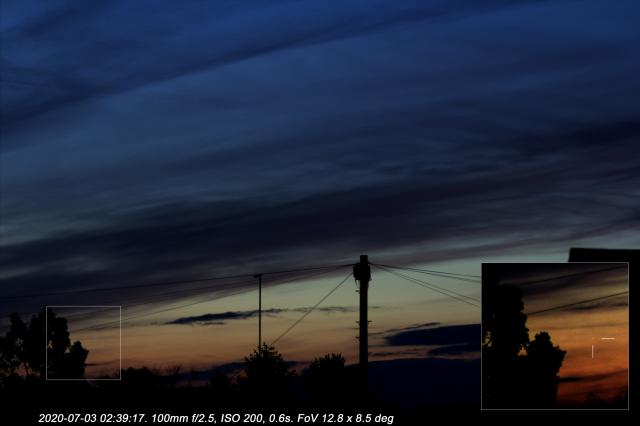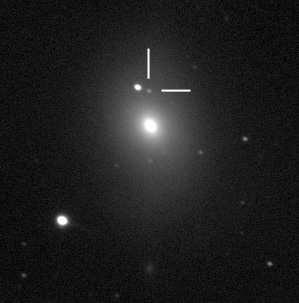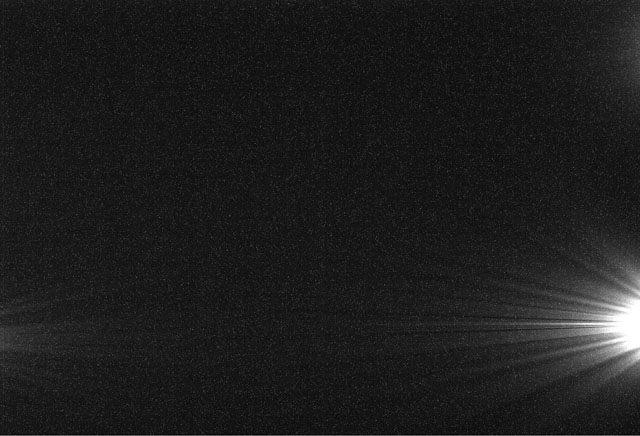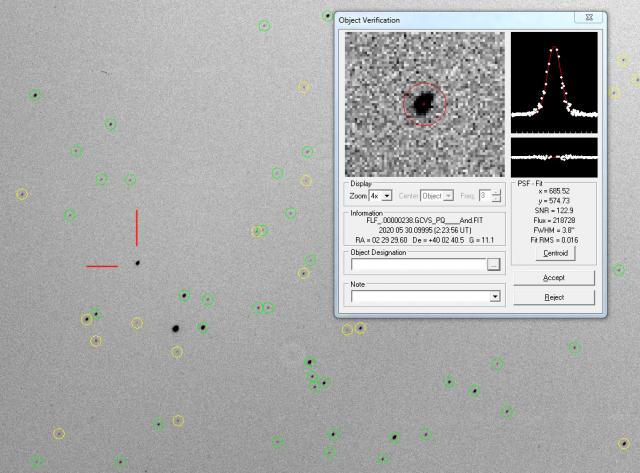Forum Replies Created
-
AuthorPosts
-
 Nick JamesParticipant
Nick JamesParticipantGreat pictures from everybody. You just had to be lucky with the weather last night.
It is not quite up to Michael Jager’s standard and it shows the comet rising over TV aerials and trees rather than mountains but here is a short timelapse of C/2020 F3 rising from Chelmsford last night. It first appears at 0131 when the comet is 1.7 deg above the horizon.
 Nick JamesParticipant
Nick JamesParticipantClear in Chelmsford this morning. Here is a single raw 3.2s frame of C/2020 F3 from this morning (for some reason my images are really dark when uploaded to the BAA site, the original is here. I have lots of frames which I’ll process properly after work today but need some sleep now. Great view in binoculars. Didn’t see it naked eye but theta Aur was very hard NE that low in a bright sky.
 Nick JamesParticipant
Nick JamesParticipantIt is an impressive sequence. At the risk of unpopularity here is the link! The comet is probably mag 1 or so at the moment but seen against a very bright sky. As you say, Monday looks like our best chance weather-wise over the next few days. I’ll certainly be making the effort to get up early.
 Nick JamesParticipant
Nick JamesParticipantI had similar conditions but I think I got it (see attached). I have images taken 10 mins earlier that show stars so I can get a good reference position for the expected azimuth and elevation and it is in the right place. It is also moving at sidereal rate from images before and after this one.

 Nick JamesParticipant
Nick JamesParticipantRobin,
M85 is getting low in a bright sky but this is an image from a few minutes ago showing the SN. It doesn’t seem much brighter (Astrometrica gives 17.5 unfiltered using Gaia DR2 G and an unfiltered KAF-6303 CCD).
 18 June 2020 at 11:02 pm in reply to: Tynemouth: a significant site in the history of astronomy? #582650
18 June 2020 at 11:02 pm in reply to: Tynemouth: a significant site in the history of astronomy? #582650 Nick JamesParticipant
Nick JamesParticipantDavid, so you follow in illustrious footsteps! Chelmsford has Calver of course. A more recent connection but not an orbital dynamicist.
 Nick JamesParticipant
Nick JamesParticipantThe cost of these photometric filters is pretty eye-watering compared to the bog-standard LRGB filters that people use for imaging. As Robin says it is necessary to calibrate the transformation coefficients for any particular sensor in any case and you then need to image in multiple bands so you can apply those coefficients. It may not be perfect but could you use imaging RGB filters and transform them to something close to the standard photometric bands? I know that people use DSLRs for variable work and do something similar with the Bayer RGB pixels. I’ve certainly found that the green pixels of my ASI294 match Gaia G quite nicely and I use a neat tool called rawtran which transforms the RGB into other photometric bands. It seems to work pretty well with reference to APASS photometry.
 Nick JamesParticipant
Nick JamesParticipantIs there something special about spectroscopy that would mean that scaling darks was a normal thing to do? Unlike flats, darks are really easy to obtain so I don’t really understand why you wouldn’t just take a set of darks corresponding to the exposure/temperature that you use for images.
Regarding amp glow I have a ZWO ASI294MC which uses the Sony IMX294. The amp glow in darks is a bit spectacular (see attached for a 120s example at -10C) but it calibrates out completely. I rarely go beyond 120s since stacking algorithms work much better if they have lots of frames to stack and the read-out noise and dead time of these cameras is negligible.

 Nick JamesParticipant
Nick JamesParticipantI don’t see any reason why CMOS should be any different to CCD if you are careful not to saturate either the individual subs or the final stack and the images are calibrated accurately. Due to much lower read noise and much faster readout times CMOS tends to be used with shorter exposures so the smaller well depth and reduced bit depth (12 or 14 bits rather than 16 bits) are not really relevant. If the standard deviation of the noise in each image exceeds a few LSBs than the quantization is not relevant anyway whichever technology you are using. A key thing if you stack images before measuring them is to use mean rather than sum and ouput the resulting FITS as float rather than int to avoid saturation and quantization effects.
CMOS and CCD have the same problems as far as calibration is concerned (flats, darks etc) and in terms of aligning wavelength sensitivity with standards (filters etc) but otherwise they are pretty similar. CMOS has many other advantages so it won’t be long before CCD detectors are only available for very specialist applications.
 Nick JamesParticipant
Nick JamesParticipantThat doesn’t look very stable Mr. Poyner. The cat looks to be a Brummie relative of bagpuss.
 Nick JamesParticipant
Nick JamesParticipantBlimey, it really was a long time ago. I had some hair then.
Nick.
 Nick JamesParticipant
Nick JamesParticipantI had to wait until it was almost daylight for it to clear my house roof but here it is. I’ll need to dig out my nova patrol films from 1989 to see the last time I got it this bright.

 Nick JamesParticipant
Nick JamesParticipantTHE ASTRONOMER Electronic Circular No 138 1988 Mar 26 14.32UT.
Telecom Gold 72:MAG60138
Ed:Guy M Hurst, 16, Westminster Close, Kempshott Rise, Basingstoke,
Hants, RG22 4PP, England. Telephone:(0256)471074.Int:+44256471074
Telex:265871(MONREF G) Quote”72:MAG60138 ATT G.HURST”in FIRST line.
——————————————————————-
TAV0226+39 = VAR OBJ IN AND
M.Mobberley and G.Hurst report confirmation of the new object
announced on E137. Available magnitude estimates (some re-reduced):
1988 Feb 12.802UT,(11.5pv M.Mobberley 85mmFL f2 Tri-X
Mar 15.835UT,( 9.0pv N.James 55mmFL
1988 Mar 21.900UT, 10.0pv D.McAdam 305mmFL f4 K2415
21.913UT, 10.0pv D.McAdam 305mmFL f4 K2415
25.844UT, 10.8pv M.Mobberley 0.36-m f5 refl. Tri-X
25.844UT, 10.6v G.Hurst 0.44-m refl.
N.James, Chelmsford, reports the object is not present on patrol
photos with the following limiting magnitudes:
1986 Dec 6, 10; 1987 Feb 20, 10; Oct 17, 11; Nov 14, 11;
1988 Jan 20, 11; Feb 12, 11.
G.Hurst reports a revised position from analysis of the discovery
photos:
RA 02h26.3m DEC +39 50′(1950)
There is no candidate on Atlas Stellarum to an approx limiting
magnitude of 13.8B. (1969 Aug 9).
Preliminary sequence:
Comp RA(1950) DEC(1950) mv Source
A 02 27.6 +39 57 6.8 CSI
B 02 26.3 +39 47 8.7 M34 Transfer
C 02 25.7 +39 39 9.3 do.
D 02 25.9 +39 39 10.2 do.
E 02 25.6 +39 43 10.6 do.
F 02 26.2 +39 47 10.8 do.
G 02 26.3 +39 49 11.2 do.
The discovery has been communicated to the Central Bureau by telex
and as yet, no independent results have been announced.
Guy M Hurst Nick JamesParticipant
Nick JamesParticipantI’m sure Guy won’t mind me posting this here. This is from my archive as downloaded using a 1200 baud modem…
THE ASTRONOMER Electronic Circular No 137 1988 Mar 24 19.04UT.
Telecom Gold 72:MAG60138
Ed:Guy M Hurst, 16, Westminster Close, Kempshott Rise, Basingstoke,
Hants, RG22 4PP, England. Telephone:(0256)471074.Int:+44256471074
Telex:265871(MONREF G) Quote”72:MAG60138 ATT G.HURST”in FIRST line.
——————————————————————-
VARIABLE OBJECT IN AND= Q1988/18
D.McAdam, Telford, reports his discovery of a variable object in
And. The stellar object, of mag approx 10.5pv is present on two
photos taken on 1988 Mar 21 at 21.36UT and 21.55UT for the UK
Nova/Supernova Patrol. The position is:
RA 02h26.5m DEC +39 50′(1950)
The object was not present on photos of Jan 22 and to date no
variable or asteroid candidate has been found.
Observers with a clear sky tonight are urgently requested to check
the field and report their findings by e-mail using ‘EXPRESS’.
Guy M Hurst Nick JamesParticipant
Nick JamesParticipantI remember Dave from the old TA days. A great guy. I chased up a few of his suspects back in the late 80s. I remember discussing the TA/VSS computer archive with him when computers weren’t quite what they are today.
I’ll have a go at getting some images from here tomorrow morning but it will have to wait until the sky is quite bright.
 Nick JamesParticipant
Nick JamesParticipantVery useful stream. It’s running fine for me.
 Nick JamesParticipant
Nick JamesParticipantDitto for me. I haven’t refocused mine for years (3.8mm, f/0.8). My main problem is spiders. Now that planes are mostly gone they are a major source of false triggers on my cams. I have a brush on a long pole for dealing with them but they don’t stay away for long.
 Nick JamesParticipant
Nick JamesParticipantAnother thing I mentioned in Sky Notes that immediately got cancelled.
 Nick JamesParticipant
Nick JamesParticipantDid you mean the Circulars (at the link provided by Martin) or the e-bulletins? The e-bulletins were archived somewhere but I can’t find them on this site.
 Nick JamesParticipant
Nick JamesParticipantI agree. It was an inspired idea from Andy and Dominic to get these going. They have been really popular and I hope that we can continue them in some form even when things get back to normalish.
-
AuthorPosts
